Introduction
Being one of those freaky weird IT people who are passionate about backups*, when Apple first previewed Mac OS X 10.5 (aka Leopard), the number one thing I of course got excited about was Time Machine. Now, before anyone tells me that it’s “just a poor rip-off of VSS”, let me be blunt – analysts who started that talk have no clue what they’re talking about.
Yes, VSS is great on Windows systems – in fact, its great to see that standard VSS functionality has reached a point in NetWorker 7.5 that it’s just part of the Windows client for filesystem backups, rather than requiring additional licenses.
But VSS in itself is not in the same league as Time Machine for end user backup – and more importantly, recovery – and quite frankly, that’s more important when we’re talking about non-server backup systems.
Evaluating it as an end-user backup system
If you’re not fully across Time Machine, here’s how it works:
- You plug a new or otherwise unused hard drive into your Mac.
- The OS asks you if you want to use that drive for Time Machine backups.
- You answer Yes**.
That’s all there is to getting basic Time Machine backups running. At that point, Time Machine does a full backup, then from that point onwards does incremental backups making use of hard links, thus making very efficient use of space. Backups are taken every hour, and it manages backups such that:
- Hourly backups are kept for 24 hours.
- Daily backups are kept for a month.
- Weekly backups are kept until the disk becomes full.
All pruning of space is automatically handled by the OS. For the system volume at least, Time Machine is an exclusive backup product – it backs up everything by default, and you have to explicitly tell it what you want excluded from the backup. This is a Really Good Thing. However, you can go into preferences and exclude other regions (e.g., I have a “DNB” (Do Not Backup) folder on my desktop that I drop stuff into for temporary storage), or explicitly include other drives attached to the system.
Overall the settings for Time Machine are simple – very simple:
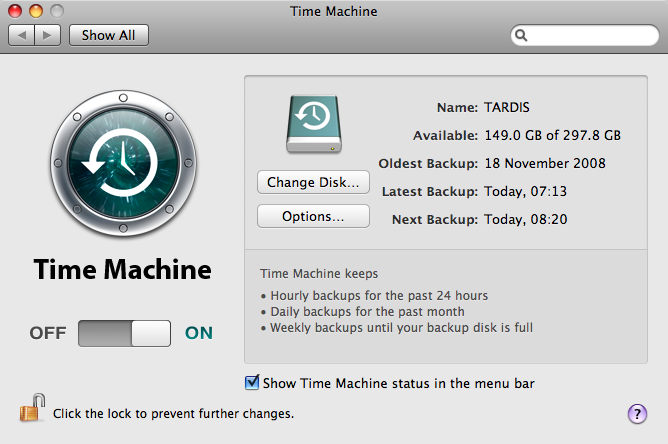
The Options button is what allows you to manage exclusions for your backups:
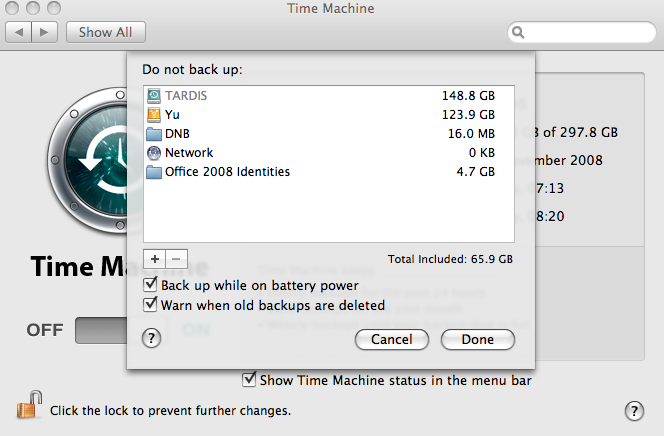
To be honest though, who cares about backup? Desktop backup products abound, and in reality what we care about is whether you can recover. Indeed, for desktop products what we care most about is whether our parents, or our grandparents, or those people down the street who ask us for technical support simply because we’re in IT, can recover. Boy, can you recover.
Time Machine presents a visually beautiful way of browsing the backups. Unfortunately we won’t see it appear in other backup products because, well, according to Steve Jobs when it was first introduced, Apple took out a lot of patents on it***. The standard recovery browser will look like the following:
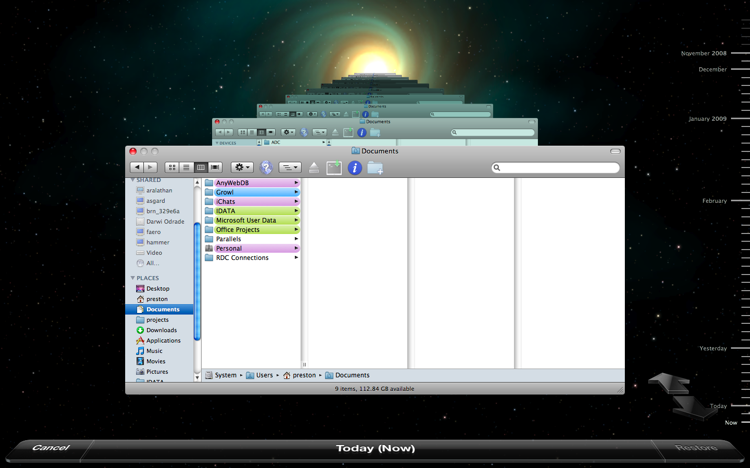
Equally importantly though, Time Machine isn’t just about facilitating file level recoveries, but also recoveries of other data that it understands – such as say, mail. Now, yes, enlightened readers will point out that Apple’s Mail.app program stores mail in files and thus is easily browseable, but the files aren’t named in such a way that say, my father could work out which file needs to be recovered.
Here’s an example of what Time Machine looks like when browsing for recovery of mail:
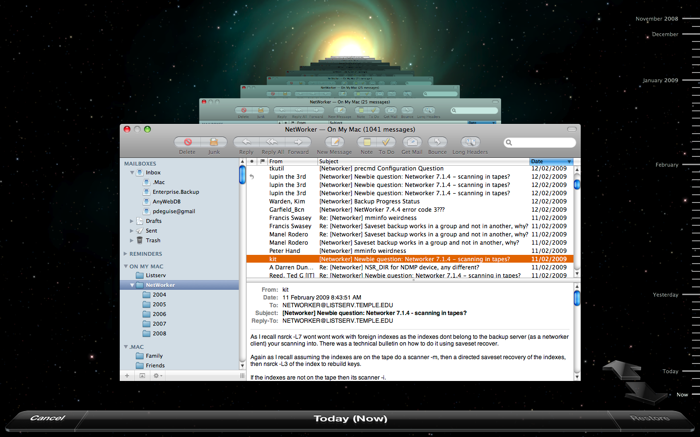
To browse and retrieve email, the user simply browses through the folder structure – and the time of the backups – to pick the email(s) to be recovered. It’s incredibly intuitive, and takes less than 5 minutes to learn for the average user. As an enterprise backup consultant, honestly, I almost cried when I saw this and thought about how much of a pain message level recovery has been for so long. (Yes, getting better now, and has been for a while.)
Browsing back in time is straight forward – just scroll the mouse over the time bar on the right hand side of the screen and select the date you want:
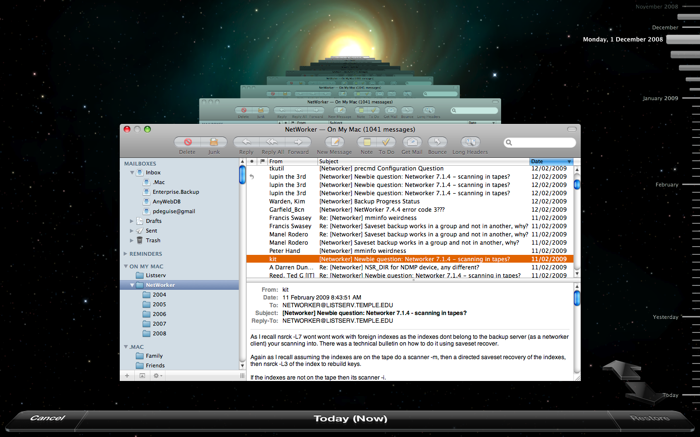
This, quite honestly, is the epitome of simplicity. Going beyond standard backup and recovery operations, Time Machine is also an excellent disaster recovery tool – if you have serious enough issues that you need to rebuild your machine, the Mac OS X installer actually has the option of doing a rebuild and recovery from Time Machine backups.
To be blunt – as a backup utility for end users, Time Machine is an ace in the hole, and one of the most underrated features of Mac OS X.
There are some things that I think are lacking in Time Machine at the moment that will only come in time:
- Support for multiple backup destinations – savvy users want to be able to swap out their backup destination periodically to take it off site.
- Granular control of timing – some users complain that Time Machine affects the performance of their machine too much. Personally, I consider myself a power user and have not noticed it slowing me down yet, but others feel that it does, and don’t like the frequency at which it backs up. Being able to choose whether you want your most frequent backups done hourly, 2-hourly, 3-hourly, 4-hourly, etc., would be a logical enhancement to Time Machine, and one which I hope does arrive. Personally if this were available I’d more be seeking to keep daily backups for at least a month.
- Better application support – this actually isn’t an Apple issue at all, but one for third party software developers. Over time, I want to see any application that does database style storage, or storage where multiple files must remain consistent, to offer Time Machine integration. (The biggest failure in this respect is Microsoft Entourage – the monolithic database format makes hourly backups via Time Machine not only impractical, but unusable.)
Still, regardless of these deficiencies, Time Machine as it currently stands was a fantastic addendum to a robust operating system, one which puts easy recovery in the hands of average users.
(I have no idea what Apple intends to do with Time Machine at the server level – while Time Machine exists on Mac OS X Server, for the most part it’s to backup the server itself plus act as a repository point for machines on the LAN, much in the same way that Apple’s Time Capsule product works. However, if they added a little bit more – say, backing up multiple clients with file level deduplication across the clients, suddenly it would be very interesting.)
Comparing it to enterprise products…
Time Machine is great for providing a backup mechanism for end users, but it pales in comparison to what enterprise backup products such as NetWorker can do for an entire environment. As such, it’s not fair to compare it against those products – it’s not in their league, and it doesn’t pretend to be there. It doesn’t support remote storage, it doesn’t support true centralisation of backups, it doesn’t support removable media, … the list goes on, and on. Most importantly for any enterprise however, it doesn’t really support native backups of other operating systems. (Yes, you can shoe-horn it into say, backing up a SMB or CIFS share, but like any such form of backup, it’s not a true, integrated solution.)
As such, Time Machine isn’t something that’s going to replace your NetWorker environment. Chances are it won’t even replace your Retrospect environment. Used correctly though, it can act as a valuable enhancement in a backup environment, but if you’re a backup administrator, it isn’t going to put you out of a job today, next week, next year, or even in the next 5 years.
—
* Honestly, tell someone in a different discipline in IT that you specialise in data protection and that you enjoy it, and watch their eyes glaze over…
** Or in my case, since I can never resist the temptation, you answer no, and rename the disk to TARDIS, since if it’s going to be a Time Machine, it may as well be a good one.
*** Good for them. It’s tiresome watching what sometimes seems to be the entire computer industry using Apple as a free R&D centre.
1 thought on “Aside – My take on Time Machine”